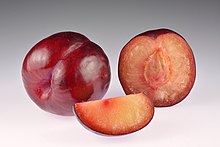Plum
| Plum | |
|---|---|

| |
| Scientific classification | |
| Kingdom: | |
| (unranked): | |
| (unranked): | |
| (unranked): | |
| Order: | |
| Family: | |
| Subfamily: | |
| Genus: | |
| Subgenus: | Prunus
|
| Species | |
|
See text. | |
A plum is a sweet fruit that grows on a plum tree. The scientific name for the tree is Prunus domestica. When the fruit is dried, it is called a prune. The color "plum" takes its name from the fruit.
Prunus domestica is the European plum. Most of the plums we eat are grown on varieties of this tree. Greengages and damsons are varieties of plum.
The plant is usually a large shrub or a small tree. It has attractive white blossom in spring. The branches often have thorns. The fruit can be up to 8 cm across, and is usually sweet (dessert plum). Some varieties are sour and require cooking with sugar. The fruit has a single large seed inside.
Some plum trees need another plum tree growing nearby to fertilise the flowers. Without this the plum tree may not produce any fruit.
Plum colored plums are called purple plums and are a deep purple color; other plums are reddish purple. Some other plums can be yellow, red, green or even white. The fruit has a groove running down one side, and a smooth stone (seed). The flesh of the fruit is brownish and is very juicy. The skin can be eaten. It can also be used to make jam and the juice can be used to make wine. It is closely related to the apricot.
Plums contain many nutrients but is highest in vitamin C and potassium. A single plum contains approximately 6 grams of vitamin C and 100 grams of potassium.
Cultivation[change | change source]
There are many cultivars of plum. Plums come in a wide variety of colors and sizes. Some are much firmer-fleshed than others, and some have yellow, white, green or red flesh, with equally varying skin color. These are some of the best-kown:
- Damson (purple or black skin, green flesh, clingstone, astringent)
- Greengage (firm, green flesh and skin even when ripe)
- Yellowgage or golden plum (similar to greengage, but yellow)
- Victoria plum (yellow flesh with a red or mottled skin)
- Satsuma plum (firm red flesh with a red skin)
- Mirabelle plum (dark yellow, mostly grown in northeast France)
Related pages[change | change source]
References[change | change source]
- ↑ D. Potter; T. Eriksson; R. C. Evans; S. Oh; J. E. E. Smedmark; D. R. Morgan; M. Kerr; K. R. Robson; M. Arsenault; T. A. Dickinson; C. S. Campbell (2007). "Phylogeny and classification of Rosaceae" (PDF). Plant Systematics and Evolution. 266 (1–2): 5–43. doi:10.1007/s00606-007-0539-9. S2CID 16578516. Archived from the original (PDF) on 2013-11-24. Retrieved 2018-07-04. Note that this publication pre-dates the 2011 International Botanical Congress which mandates that the combined subfamily referred to in the paper as Spiraeoideae must be called Amygdaloideae.("Article 19 – Ex.5". International Association for Plant Taxonomy. Archived from the original on 2016-03-04.)
Other websites[change | change source]
- Prunus americanum images at bioimages.vanderbilt.edu Archived 2017-09-08 at the Wayback Machine
